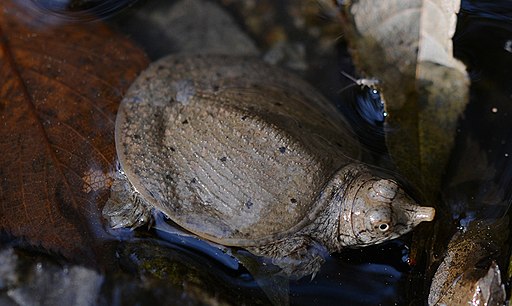Superregnum: Eukaryota
Regnum: Animalia
Subregnum: Eumetazoa
Cladus: Bilateria
Cladus: Nephrozoa
Superphylum: Deuterostomia
Phylum: Chordata
Subphylum: Vertebrata
Infraphylum: Gnathostomata
Megaclassis: Osteichthyes
Superclassis: Sarcopterygii
Superclassis: Tetrapoda
Cladus: Reptiliomorpha
Cladus: Amniota
Classis: Reptilia
Cladus: Eureptilia
Cladus: Romeriida
Subclassis: Diapsida
Cladus: Sauria
Cladus: Archelosauria
Division: Pan-Testudines
Division: Testudinata
Ordo: Testudines
Subordo: Cryptodira
Superfamilia: Trionychoidea
Familia: Trionychidae
Subfamilia: Trionychinae
Genus: Pelodiscus
Species: Pelodiscus maackii
Name
Pelodiscus maackii Brandt 1857:609
Type locality: rivers south of the Amur River, namely Sungari and Ussuri Rivers and course of the Amur River between the Sungari and Ussuri Rivers.
Holotype: lost
Synonyms
Trionyx maackii - Brandt 1858:609
Amyda maacki — Stejneger, 1907:529
Pelodiscus maackii — David 1994:35
Pelodiscus maackii — Fritz & Havas 2007:318
References
Brandt, Johann F. 1858. Observationes quaedam ad generis trionychum species duas novas spectantes. Bull. Acad. Imper. Sci. St. Petersbourg, classe Phys.-Mathemat., 16(9): cols. 110-111 (reprinted in Mél. Biol. Acad. Sci. St. Pétersbourg 2: 609–610, 1857)
Fritz, U. & Havas, P. 2007. Checklist of chelonians of the world. Vertebrate Zoology 57(2):149-368
Turtle Taxonomy Working Group (van Dijk, P.P., Iverson, J.B., Rhodin, A.G.J., Shaffer, H.B. & Bour, R.) 2014. Turtles of the world, 7th edition: annotated checklist of taxonomy, synonymy, distribution with maps, and conservation status. Chelonian Research Monographs 5(7):000.329–479 Reference page.
Pelodiscus maackii at the New Reptile Database
Vernacular names
čeština: Kožnatka amurská
English: Northern Chinese softshell turtle
Pelodiscus maackii, commonly known as the Amur softshell turtle[3] or the northern Chinese softshell turtle, is a species of turtle in the family Trionychidae. The species is found in the Russian Far East, northeastern China, Korea, and Japan.[4] It is possible that the Japanese populations are the result of ancient introductions by humans.[4] This aquatic species may attain a straight carapace length of 32.5 cm (1.1 ft).[5]
Etymology
The specific name, maackii, is in honor of Russian naturalist Richard Maack.[3]
References
"Appendices | CITES". cites.org. Retrieved 2022-01-14.
Fritz, Uwe; Havaš, Peter (2007). "Checklist of Chelonians of the World" (PDF). Vertebrate Zoology. 57 (2): 318–319. ISSN 1864-5755. Archived from the original (PDF) on 17 December 2010. Retrieved 29 May 2012.
Beolens, Bo; Watkins, Michael; Grayson, Michael (2011). The Eponym Dictionary of Reptiles. Baltimore: Johns Hopkins University Press. xiii + 296 pp. ISBN 978-1-4214-0135-5. (Pelodiscus maackii, p. 164).
Rhodin, A.G.J., Iverson, J.B., Bour, R. Fritz, U., Georges, A., Shaffer, H.B., and van Dijk, P.P. (Turtle Taxonomy Working Group) (2017). Rhodin, A.G.J.; Iverson, J.B.; van Dijk, P.P.; Saumure, R.A.; Buhlmann, K.A.; Pritchard, P.C.H.; Mittermeier, R.A. (eds.). "Turtles of the World: Annotated Checklist and Atlas of Taxonomy, Synonymy, Distribution, and Conservation Status" (PDF). Chelonian Research Monographs. Conservation Biology of Freshwater Turtles and Tortoises: A Compilation Project of the IUCN/SSC Tortoise and Freshwater Turtle Specialist Group (8 ed.). 7: 1–292. doi:10.3854/crm.7.checklist.atlas.v8.2017. ISBN 9781532350269. S2CID 89826255. Archived from the original (PDF) on 2020-02-13.
"Chinese Soft-shell Turtle". Ecology Asia. Retrieved 28 September 2017.
Further reading
Brandt JF (1857). "Observationes quaedam ad generis Trionychum species duas novas spectantes ". Bulletin de la Classe Physico-Mathématique de l'Académie Impériale des Sciences de Saint-Pétersbourg 16: 110–111. (Trionyx maackii, new species). (in Latin).
Stejneger L (1907). Herpetology of Japan and Adjacent Territory. Smithsonian Institution, United States National Museum Bulletin 58. Washington, District of Columbia: Government Printing Office. xx + 577 pp. (Amyda maackii, p. 529).
Retrieved from "http://en.wikipedia.org/"
All text is available under the terms of the GNU Free Documentation License


